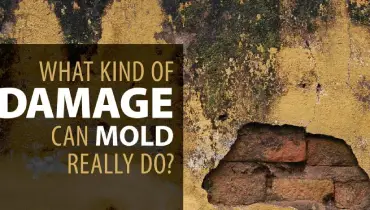
According to Rainbow Restoration, mold can cause significant harm to both property and health.
|
Excessive mold exposure can cause symptoms of hay fever in healthy individuals and lung infections in immune-compromised people or patients with chronic lung disease. Toxic mold is even worse, potentially causing breathing difficulties, headaches, fatigue, rashes, mental impairment, and even death.
Mold is a scary health issue, but what kind of property damage can it cause? If ignored, mold damage can escalate in a matter of weeks. Here’s a look at the kind of damage mold can do and the corresponding cleanup and remediation tasks you must perform.
Mold Damage Level I: 10 Square Feet or Less
If you discover mold growth quickly enough, you may catch it at contamination level 1. At this point, you can clean up the mold without a professional’s help. Just follow these guidelines:
- Don’t attempt DIY mold cleanup if you have asthma, allergies, or an immune disorder.
- Wear rubber gloves, goggles, and an N95 disposable respirator.
- Evacuate sensitive individuals before you start the mold cleanup process, including infants and people with lung disease or recovering from surgery.
- Dispose of contaminated porous materials, such as carpet and ceiling tiles, in sealed plastic bags.
- Run a wire brush over moldy surfaces followed by disposable wipes. Clean the area with a cloth or mop dipped in a detergent solution. This process works for mold removal from wood as well as non-porous surfaces such as tile, glass, and metal.
- Dry all cleaned surfaces and make sure no visible mold remains.
- If applicable, address the moisture issue that caused the mold growth to prevent it from happening again.
Mold Damage Level II: 10-30 Square Feet
The same precautions from level I apply here with these additional requirements:
- Cover unsalvageable moldy materials with plastic sheets sealed with tape before handling or removing them.
- Vacuum the work area with a HEPA vacuum cleaner, and then wipe down all surfaces with a cloth dipped in a detergent solution.
Mold Damage Level III: 30-100 Square Feet
When mold spreads to an area the size of several wall panels, even more care is required during the cleanup process. Homeowners should seriously consider hiring a professional remediation company. At this level, it becomes necessary to tape plastic sheeting over air registers to prevent contaminating HVAC ducts.
Mold Damage Level IV: 100 Square Feet or More
This degree of mold contamination requires professional remediation, no matter how confident you are. Everyone working on the task should be trained in handling hazardous materials and wear full-face respirators with HEPA cartridges and disposable protective clothing. Here’s what to expect from a mold damage cleanup crew:
- Isolate the area from the rest of the house with sealed plastic sheeting over doorways, air registers, fixtures, and other openings.
- Set up a decontamination chamber to remove disposable clothing after the mold remediation is complete.
- Monitor indoor air quality before allowing residents to move back in.
Mold Damage Level V: HVAC System Contamination
All mold growth in your HVAC system should be removed by a professional, no matter how large or small the area is. Mold remediation for a space larger than 10 square feet should follow these precautions:
- Shut down the HVAC system.
- Properly dispose of contaminated insulation.
- Use a biocide product to kill inaccessible mold growth inside the ductwork.
If you find mold hiding in your house, trust Rainbow Restoration® to remove the contamination. We follow important safety protocols and proven mold remediation techniques to clean up your home properly. We also address the moisture that caused mold to grow in the first place to prevent a recurrence.
To schedule mold remediation services, please contact Rainbow Restoration.
To help meet all of your home service needs, check out Neighborly.
